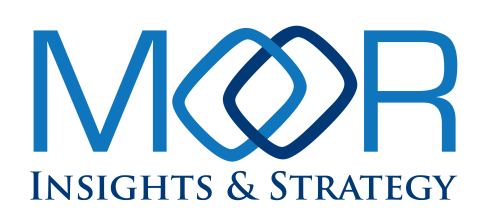
The Moor Insights & Strategy team hopes you had a nice weekend!
Last week, Anshel attended Google’s Made by Google event in Mountain View, California, and Jason attended (virtually) AI Innovation through AWS Workplace.
On Wednesday, August 21st (9 am PT / 12 pm ET), Will Townsend is hosting a free live webinar with Nile: From Complexity to Cloud-Native: Top 10 Reasons to Start Building Your Next-Gen Enterprise Network.
Later this month, Matt will attend VMware Explore virtually while Will attends in person and Patrick Moorhead and The Six Five crew will broadcast live. Matt will then attend a GlobalFoundries analyst event in Santa Clara, and Robert will attend the IBM SAP Analyst and Advisory Services Day in New York. Melody and Robert will attend the US Open with IBM in New York.
Last week, our MI&S team published 14 deliverables:
6 Forbes Insight Columns
1 MI&S Research Note
3 MI&S Blog Posts
4 Podcasts
Over the last week, our analysts have been quoted three times in international publications with our thoughts on Crowdstrike, Google, and T-Mobile.
MI&S Quick Insights
X.ai has released its frontier model, Grok-2 mini, on the X platform. I ran it through its paces; its image performance is impressive and blazing fast. It has been evaluated across academic benchmarks, including reasoning, reading comprehension, math, science, and coding. The model is available to X Premium and Premium+ users. X is also collaborating with Black Forest Labs to test its FLUX.1 model. Over the weekend, I’ll test X’s enhanced search capabilities, insights on X posts, and improved reply functions.
Google DeepMind’s Imagen 3 is a text-to-image model for generating high-quality images from text prompts. This model outputs exceptionally photorealistic images at a default resolution of 1,024 x 1,024 pixels, with options for higher resolution, and it outperformed other leading text-to-image models in human evaluations. Training used a large dataset of images paired with original and synthetic text descriptions. To ensure the model’s quality and safety, a rigorous multi-stage filtering process was implemented to remove unsafe, violent, or low-quality images and eliminate AI-generated images to prevent learning biases. Additionally, synthetic captions were generated with multiple Gemini models to provide diverse and high-quality linguistic input. Captions were filtered for unsafe or personally identifiable information. In short, Imagen 3 offers superior image quality while prioritizing ethical considerations and safety in its deployment.
X.ai has released its frontier model, Grok-2 mini, on the X platform. I ran it through its paces; its image performance is impressive and blazing fast. It has been evaluated across academic benchmarks, including reasoning, reading comprehension, math, science, and coding. The model is available to X Premium and Premium+ users. X is also collaborating with Black Forest Labs to test its FLUX.1 model. Over the weekend, I’ll test X’s enhanced search capabilities, insights on X posts, and improved reply functions.
Google DeepMind’s Imagen 3 is a text-to-image model for generating high-quality images from text prompts. This model outputs exceptionally photorealistic images at a default resolution of 1,024 x 1,024 pixels, with options for higher resolution, and it outperformed other leading text-to-image models in human evaluations. Training used a large dataset of images paired with original and synthetic text descriptions. To ensure the model’s quality and safety, a rigorous multi-stage filtering process was implemented to remove unsafe, violent, or low-quality images and eliminate AI-generated images to prevent learning biases. Additionally, synthetic captions were generated with multiple Gemini models to provide diverse and high-quality linguistic input. Captions were filtered for unsafe or personally identifiable information. In short, Imagen 3 offers superior image quality while prioritizing ethical considerations and safety in its deployment.
At the end of July, I published a piece on Forbes.com suggesting that CRMs are an ideal place to begin the AI journey. While the overall feedback on the article has been good, one very specific item of feedback is worth mentioning here. In my article I mentioned that a great use case for AI in CRM would be to find a way to reduce the effort of entering data into CRMs for front-line salespeople. I even posited using meeting summarization technology as a way to do this. Turns out there is a company that is attempting to use AI to create an omnichannel workflow for customer sales and service interactions and manage those interactions in its own CRM. The company is called Flowcall, and for businesses that heavily use online sales and service, it looks like an interesting way to automate.
I have been a part of multiple inquiries this week in the lead-up to technology conferences this fall. While I cannot elaborate with any details, there are a few themes emerging in the dev space that will be coming your way soon. (1) What are the second-generation AI features now that AI assistants and agents are everywhere? (2) Improving and simplifying developer responsibility and security. (3) DevOps and convergence with other IT Automation technologies. Topic number three is so interesting and applies much more broadly than just to developers. So much so, that Matt Kimball and I will be launching a new podcast for anyone with “*/ops” in their job description. The Moor Insights and Analysis Ops Podcast is launching very soon. Stay tuned!
Expansion of Nutanix-Dell partnership: Given the dynamic nature of the virtualization and hybrid cloud market, it seems as if new alliances are being formed every day. One of the biggest movers in the game has been Nutanix, which has built on a strong market position with its Nutanix Cloud Platform (NCP) and hardware partnerships. One of those partnerships has been with Dell, whereby the companies cooperate to perform joint go-to-market on integrated solutions.
This week, the companies upped the ante with the availability of the Dell XC Plus, a hybrid cloud platform with a centralized control plane, advanced management, and AI-driven performance tuning. Additionally, Dell announced that its PowerFlex will be the first external storage platform supporting the Nutanix Cloud Platform and the Nutanix AHV hypervisor. This software-defined storage solution enables enterprise IT organizations to scale compute and storage independently.
So, what is the significance of this announcement? A few things. First and foremost, this partnership shows, as previously mentioned, that Nutanix is capitalizing on the uncertainty in the virtualization and hybrid cloud market through the partnerships it has been able to establish. These are partnerships that go beyond superficial integrations and a datasheet. The company is building deep integration with hardware partners like Dell and following that with well funded joint go-to-market efforts that should land well in the enterprise.
This partnership also demonstrates why Dell is the number one server vendor in the market. The company has the uncanny ability to respond to the needs of its customers with partnerships like these at the right time.
HPE’s acquisition of Morpheus Data, an orchestration and management platform, filled a gap in the company’s hybrid cloud solution. It’s the latest move in the company’s hybrid cloud strategy, following a series of announcements at the annual HPE Discover conference, where the GreenLake virtualization stack was unveiled. For the GreenLake platform, Morpheus fills critical holes for infrastructure and cloud management, complementing what the company offers in OpsRamp.
What does this mean for enterprise IT and GreenLake customers? There are a couple of ways to look at this. There’s the obvious value-add to GreenLake as Morpheus complements infrastructure management (also provided by OpsRamp) and delivers a rich cloud management platform for the hybrid cloud environment. And there’s a lot packed into that “rich cloud management” statement: Morpheus offers a single console for self-service, consumption and management, managing cloud spend, and so on. Morpheus is the orchestration layer that brings all of the enterprise tools together to enable that real point-and-click experience for both users and IT administrators. I can tell you as somebody who spent a few years in IT management—complexity is the enemy of IT. If I can find a platform that allows my own team and those I support (business units, embedded DevOps teams) to do more easier and faster, I can focus on the projects that have higher visibility and priority across the organization.
The other way to look at this is to think about how enterprise IT is moving toward deploying bespoke, complete solution stacks—from silicon to server to software—that serve the needs of the business. So, GreenLake customers may also have Dell or Cisco deployed for other purposes. In this case, Morpheus enables enterprise IT organizations to manage a larger part of their data estate (maybe all of it) from a single platform. That’s a big win.
I’m really curious to see how HPE handles the integration of Morpheus into its portfolio. Integration of technology portfolios is equal parts science and art. Further, Morpheus’s support for the broader server market must be taken into consideration.
Lenovo’s Infrastructure Solutions Group (ISG) had an incredibly strong Q1FY25, showing 65% year-over-year growth, driven by cloud and HPC. In addition, the company narrowed its losses, though the amount of that narrowing was not articulated. While this is encouraging to see, perhaps more encouraging is acknowledgement from the unit’s new co-presidents that the commercial market (SMB and enterprise) is critical to long-term success. Hopefully we will see go-to-market efforts that are aligned to those words.
HYCU has a new report, “The State of SaaS Resilience in 2024,” that reviews vulnerabilities in SaaS data protection. It’s based on a survey of 417 global IT practitioners. The report details significant gaps—one of which is no shocker: businesses are underestimating the number of SaaS applications in use. They are also over-relying on SaaS vendors for data protection and lacking skilled staff to manage SaaS data security. With 61% of ransomware attacks targeting SaaS applications, many businesses struggle to recover encrypted data quickly, posing significant operational risks. The report also offers best practices to enhance SaaS data resilience.
This report reflects what I’ve been saying. Businesses are constantly adding to their technology stacks, which is leading to problems with data protection, ERP integration, data management, and security.
Monday.com posted impressive Q2 2024 results, with 34% year-over-year revenue growth in a highly competitive market. This growth is also shown in monday.com’s headcount increase amidst widespread layoffs across the tech industry. The company has demonstrated its ability to cater to the needs of large enterprises, for example through its 49% increase YoY in customers with an ARR of $100,000 or more, and by a recently announced 80,000-seat sale to a multinational healthcare organization—the largest in monday.com’s history. Overall, the company’s performance indicates it is well-positioned to compete in the work-management space.
Cisco recently reported its Q4 earnings. Security and observability were bright spots, up 81% and 41% YoY respectively, but its core networking business was down 28% year over year. The latter is likely the rationale for an executive management realignment to create a singular focus on products and services, which has the potential to accelerate the company’s ongoing simplification strategy. It is a logical plan to reverse the slide in Cisco’s networking infrastructure sales.
ERP vendors are strategically acquiring smaller companies to modernize their platforms. Manufacturing ERP vendors such as Epicor, IFS, Infor, and Aptean have been focusing on acquisitions to enhance their capabilities within specific industries. Epicor targets companies that improve its manufacturing and distribution functions, particularly through AI-driven inventory planning and optimization. IFS and Infor are acquiring firms that expand their reach in sectors such as aerospace and revenue growth management, integrating technologies such as AI and IoT and solutions for maintenance management, data migration, and product management to better meet industry-specific demands. Aptean has acquired technology to improve its warehouse management capabilities.
Robinhood’s Q2 2024 earnings missed Wall Street expectations for user growth but surpassed revenue estimates, signaling a positive turn for the company. It also announced an upcoming desktop version of its mobile app, which should cater to more serious traders.
Transaction-based revenue surged 69% to $327 million, partly driven by a solid first half in the crypto markets following SEC approvals for bitcoin and ether ETFs. On the earnings call, the company also said it gained retail trading market share from competitors.
It’s essential to consider Robinhood’s recent success against the backdrop of its somewhat turbulent history. The company has faced regulatory challenges, experienced outages during volatile markets, and weathered a PR crisis related to the GameStop short squeeze. The ongoing debate over crypto regulation further adds to the uncertainty. However, CEO Vlad Tenev has expressed confidence in Robinhood’s ability to navigate the evolving landscape regardless of the result of the upcoming U.S. elections.
While its recent earnings beat and product announcements suggest a positive trajectory for Robinhood, the company still faces challenges. Sustaining this growth and successfully addressing regulatory concerns will be crucial factors in determining its long-term success.
Meta Quest now supports HDMI as an input so you can connect your handheld gaming device or console to the headset and experience it on a much larger virtual screen than your TV at home.
I believe that Valve’s support of SteamOS on non-Valve hardware is going to change the handheld landscape; the Asus ROG Ally is the first system to support it. I believe that Valve has better software and support for handheld gaming than any other vendor; conversely, Microsoft has really dropped the ball in addressing the needs of the market. Valve’s move could potentially shift the entire handheld market away from Windows, affecting Microsoft’s relevance in the gaming market.
In other news, Valve is testing a new alpha version of its Deadlock game, which could be one of the most successful shooter games in a long time. Truthfully, the PC gaming market has desperately needed a successful shooter game for years to boost demand for gaming systems. Right now, the most popular games are all years-old titles because they are still fun and run smoothly.
The transition to hybrid work has brought about subtle yet significant changes in how we conduct meetings, impacting employee engagement. My recent Forbes article delves into how the rise of virtual meetings and the blending of remote and in-person attendees have altered meeting dynamics, communication patterns, and overall employee experience. It explores the challenges and opportunities in this new landscape, offering insights into how organizations can adapt to foster better collaboration and engagement in a hybrid work environment.
According to a recent study by Vyopta, which makes software for monitoring and optimizing meetings and digital collaboration, the volume of virtual meetings has remained steady even as in-person meetings have more than doubled since the pandemic. Vyopta’s research findings point to a connection between virtual meeting engagement and employee retention. It suggests that verbal and visual active participation creates a sense of connection and belonging, which could influence an employee’s decision to stay with a company. Organizations need to rethink their virtual meeting strategies and address the underlying causes of disengagement—which I believe can be addressed with the right technologies—to improve employee retention and productivity.
A different recent industry report, “AI and the Workforce: Industry Report Calls for Reskilling and Upskilling as 92 Percent of Technology Roles Evolve” highlights AI’s impact on the job market, specifically within the technology sector. The report, led by Cisco and analyzed by Accenture, reveals that 92% of the 47 information and communication technology (ICT) roles studied are expected to undergo significant changes due to AI advancements. In response, the report emphasizes the urgent need for reskilling and upskilling the workforce. It identifies critical training areas like AI literacy, data analytics, and prompt engineering as crucial for workers to adapt and succeed in the evolving landscape. The study serves as a call to action for individuals, companies, and educational institutions to proactively prepare for the AI revolution and ensure a smooth transition for the workforce.
A select group of analysts, including my MI&S colleague Will Townsend and me, had the opportunity to meet with Cisco’s EVP and chief people, policy, and purpose officer Francine Katsoudas to discuss the outcomes and some of Cisco’s plans that resulted from the study. On the call, we discussed the impact of AI on the future of workforce development, focusing on upskilling and reskilling—particularly at the entry level—to adapt to a rapidly changing job market. Cisco has emphasized the need for companies to take a proactive role in shaping the future of work and for governments to establish effective policies and frameworks to address nascent talent gaps. The company is also focused on counteracting cybersecurity talent gaps in emerging economies, particularly in Africa. I came away from the discussion impressed with Cisco’s commitment to developing programs and solutions that solve business problems while tackling real-world issues.
The big news in quantum this week is that NIST finally announced its first quantum-resistant cryptography standards:
- For general encryption, such as securing websites, ML-KEM (originally named CRYSTALS-Kyber) was chosen as the critical encapsulation method.
- For digital signatures, NIST chose two algorithms: a lattice-based algorithm called ML-DSA (originally named CRYSTALS-Dilithium) and a stateless hash-based digital signature scheme called SLH-DSA (originally called SPHINCS+).
- Another lattice-based algorithm for digital signatures called FN-DSA (originally called FALCON) has been selected for future standardization.
It looks like IBM has cornered the market on post-quantum cryptography (PQC), because ML-KEM, ML-DSA, and FN-DSA were all developed by IBM in collaboration with several industry and academic partners. SLH-DSA was co-developed by IBM and a researcher who has since joined the IBM staff.
It has taken sixteen years to produce a few useful PQC algorithms to defend against a fault-tolerant quantum computer expected to emerge ten years in the future. How long will it take us to defend our digital assets against the next threat wave, which is probably at least two decades in the future?
I went into more detail on PQC and the NIST standards in a recent Forbes piece, and I’ll publish more about this in my upcoming research notes on the Moor Insights & Strategy website.
Keysight Technology is leaning into its deep test and measurement capabilities to help the U.S. government continuously validate its security infrastructure. The company recently joined the Joint Cyber Defense Collaborative to deploy its threat simulator to test firewalls, endpoint protection, and SIEM tools with the latest malware and ransomware. It is an innovative use of Keysight’s capabilities, and one that could play a role in securing critical infrastructure and safeguarding national security.
Google has done a great job with the new Pixel 9 series, featuring a new G4 chip across four devices: the Pixel 9, Pixel 9 Pro, Pixel 9 Pro XL, and Pixel 9 Pro Fold. While I don’t love the naming for the Fold, I do think that Google is genuinely working on cohesion with the latest Made by Google products—something you really feel with the Pixel Watch 3 and Pixel Buds Pro 2.
Google is finally creating a cohesive ecosystem that builds on its progress in AI with Gemini Advanced. The new Pixel Watch 3 is everything I had hoped it would be: better battery life, faster performance, better display, improved bezel, and larger size. This will be the Wear OS watch to beat. And Google’s Gemini Live is a nice user interface upgrade to Gemini Advanced; I believe it is designed to leverage the Pixel Buds Pro 2’s A1 chip to deliver a real-time enhanced AI experience.
The rise of AI in sports is undeniable. According to Globant, the global market for AI in sports is projected to reach $19.2 billion by 2030, and its influence on everything from athlete management to game strategy is growing exponentially. AI can now predict player injuries, optimize training regimens based on real-time data, and even identify the next generation of superstar athletes through computer vision. It’s revolutionizing how we scout, train, and compete.
However, it can also get things wrong. While AI undoubtedly brings advancements, there’s a growing concern that we might lose something intangible in the process. Could data-driven decisions overshadow raw talent and the instinctive, human element of sports? Are we prioritizing algorithms over the honed intuition of experienced coaches and scouts? Will reliance on AI-generated game simulations lead to a homogenization of strategies, potentially stifling creativity and spontaneity on the field?
I believe that striking a balance between technological advancements and preserving the human spirit of competition will be vital to ensuring that AI truly enhances sport rather than over-engineering it.
As the dust settles, it’s clear that this year’s Summer Olympics in Paris showed how technology is shaping the future of sports. Let me give a few examples.
- Omega Technology — Omega’s sensors and cameras, capable of capturing 40,000 frames per second, were vital in determining outcomes in close races. For example, Noah Lyles of the U.S. won the men’s 100m dash by just five thousandths of a second over Kishane Thompson of Jamaica.
- Olympic AI Agenda — Embracing AI technology in the Olympics demonstrates not only the recognition of its importance but also strategic approaches to how it can benefit the games and support the athletes. This involves integrating AI into various aspects such as athlete performance, fan engagement, data analysis, judging, scheduling, augmented reality, governance, and more, all aimed at driving positive change across global sports.
- Security with AI — AI was used to analyze behaviors across all of the Olympic venues to identify patterns and potential threats, supported by facial recognition technology. It also monitored network traffic to detect anomalies and possible attacks. AI systems encrypted data to ensure protection against unauthorized access.
- AthleteGPT — With 10,000 athletes converging from 200 countries, many questions from them were bound to arise. AthleteGPT, a chatbot in the Athlete365 mobile app for Olympic competitors, was created to provide round-the-clock information and support to the athletes.
- Intel Corporation’s 3-D Tracking — Intel’s 3-D tracking technology was used to monitor 21 key points on each athlete, providing coaches with real-time biomechanical data to help guide future strategies. AI analyzed this data in real time to identify patterns and provide suggested changes to techniques that could enhance performance.
Watching this year’s Olympic Games was a great experience. I think France did a wonderful job, starting with a memorable opening ceremony. It was tremendous to see athletes from around the world competing in 32 sports over two weeks.
IBM brings its digital platforms to this year’s US Open. Moor Insights & Strategy’s sports technology team will be on site in Queens, New York, to provide details on how data and AI are shaping the game and enhancing the fan experience. For this year’s Open, IBM and the United States Tennis Association have introduced new generative AI features. These updates include AI-generated Match Report summaries for all 254 singles matches, enhanced AI commentary for highlight videos, and a redesigned IBM SlamTracker that offers real-time match insights. IBM will power these solutions using its technologies, including IBM the watsonx platform and Granite LLMs. In the coming weeks, follow my colleague Melody Brue and me as we discuss these developments and more on our Game Time Tech podcast and in our articles.
SK Telecom has big plans to transform itself into an AI powerhouse. The company has appointed an AI Chief who has architected what is dubbed an “AI Pyramid Strategy” focused on three pillars—AI infrastructure, transformation, and service. The strategy is in stark contrast to other mobile network operators, which are focusing on more discrete use cases and applications that leverage curated AI platforms. It is a risky gamble, given the company’s investment of tens of millions of dollars to develop its own telco LLM and personal AI assistant. However, SK Telecom has emerged as a global leader in providing innovative 5G services and it could replicate that success with its AI ambitions.
Columns Published
- Black Hat USA 2024 Showcases New Defenses for Cybersecurity Pros (Will Townsend)
- For All Its Hype, AI Isn’t Driving Cloud Growth (Yet) (Jason Andersen)
- Colorado to Copenhagen: Atom Computing’s Vision for Quantum Europe (Paul Smith-Goodson)
- The State of XR in 2024, Part 1: The Big Platform Players (Anshel Sag)
- The Silent Evolution of Meetings: Hybrid Work’s Impact on Engagement (Melody Brue)
- Clicks Keyboard Review: Bringing the Spirit of Blackberry to an iPhone (Anshel Sag)
Research Notes Published
Blog Posts Published
Podcasts Published
MI&S Insider Podcast (Will Townsend)
AMD Pensando — Silicon that Supercharges the Modern Data Center
G2 on 5G (Will Townsend and Anshel Sag)
The G2 on 5G Ep 202: FTC Rulings, Pixel 9 Launch, SK Telecom AI, DoD 5G, Network Programmability, Oracle-AT&T IoT Deal
Don’t miss future MI&S Podcast episodes! Subscribe to our YouTube Channel here.
Citations
CrowdStrike / Will Townsend / The National Care Forum
Will Townsend’s recent coverage of CrowdStrike helps explain the situation.
Google / Anshel Sag / MSN & Indian Express
Anshel Sag comments on the Pixel 9’s implementation of AI on its phone.
T-Mobile / Patrick Moorhead / The Fast Mode
Patrick Moorhead weighs in on T-Mobile’s approach to making 5G more affordable for businesses.
Anshel Sag was a guest on The Mobile Tech Podcast, where he discussed the Made by Google event and more.
New Gear or Software We Are Using and Testing
- AWS Q Developer (Jason Andersen)
- Google Notepad (for some Python) (Jason Andersen)
- Google Pixel 9 (Anshel Sag)
- Dell XPS 13 – Snapdragon X Elite (Anshel Sag)
Events MI&S Plans on Attending In-Person or Virtually (New)
Unless otherwise noted, our analysts will be attending the following events in person.
- Modern Data Quality Summit 2024, August 20 (virtual) (Robert Kramer)
- Nile Webinar Host, August 21 (Will Townsend)
- VMware Explore, August 26-29, Las Vegas (Matt Kimball – virtual, Will Townsend)
- GlobalFoundries Analyst Event, August 26-28 (Matt Kimball)
- IBM SAP Analyst and Advisory Services Day & US Open, August 29, New York (Robert Kramer)
- US Open with IBM, August 28, New York (Robert Kramer, Melody Brue)
- Modern Data Quality Summit 2024, August 20 (virtual) (Robert Kramer)
- Nile Webinar Host, August 21 (Will Townsend)
- VMware Explore, August 26-29, Las Vegas (Matt Kimball – virtual, Will Townsend)
- GlobalFoundries Analyst Event, August 26-28 (Matt Kimball)
- IBM SAP Analyst and Advisory Services Day & US Open, August 29, New York (Robert Kramer)
- US Open with IBM, August 28, New York (Robert Kramer, Melody Brue)
- IFA Berlin, September 6-11, Berlin, Germany (Anshel Sag)
- Oracle Cloud World, September 9-12, Las Vegas (Melody Brue, Robert Kramer)
- JFrog swampUP 24, September 9-11, Austin (Jason Andersen)
- Connected Britain, September 11-12, London (Will Townsend)
- Connected Britain panel moderation, September 11-12, London (Will Townsend)
- Snowflake Industry Day 2024, September 12 (virtual) (Robert Kramer)
- Snap Partner Summit, September 17, Santa Monica (Anshel Sag)
- Zayo Network Transformation webinar moderation, September 17 (Will Townsend)
- Salesforce Dreamforce, September 17-19, San Francisco (Robert Kramer)
- Intel Innovation, September 23-26 — EVENT CANCELED
- HP Imagine, September 24, Palo Alto (Anshel Sag)
- Meta Connect, September 25, San Jose (Anshel Sag)
- Verint Engage, September 23-25, Orlando (Melody Brue)
- Infor Annual Summit, September 30-October 2, Las Vegas (Robert Kramer)
- Microsoft Industry Analyst Event, Burlingame, Mass, October 2 (Melody Brue)
- LogicMonitor, Austin, October 2-4 (Robert Kramer)
- Teradata, October 7-10, Los Angeles (Robert Kramer)
- Zoomtopia, San Jose, October 8-9 (Melody Brue)
- MWC Americas and T-Mobile for Business Unconventional Awards event judge, October 8-10, Las Vegas, October 8-10, Las Vegas (Will Townsend)
- AWS GenAI Summit, October 9-10, Seattle (Jason Andersen, Robert Kramer)
- AdobeMAX, October 14-16, Miami (Melody Brue)
- Lenovo Global Analyst Summit & Tech World, October 14-17, Bellevue, WA (Matt Kimball, Paul Smith-Goodson, Anshel Sag)
- IBM Analyst Summit, October 16-18, New York City (Matt Kimball, Robert Kramer)
- Snapdragon Summit, Maui, October 20-24 (Will Townsend)
- WebexOne, October 21-24, Miami (Melody Brue)
- Cisco Partner Summit, Los Angeles, October 28–30, 2024 (Robert Kramer)
- SAP SuccessConnect, October 28-30 – virtual (Melody Brue)
- Red Hat Analyst Day, October 29 (Jason Andersen — virtual)
- GitHub Universe, October 29-30, San Francisco (Jason Andersen)
- 5G Techritory, October 30-31, Riga (Will Townsend)
- Dell Tech Analyst Summit, November 6-8, Austin (Matt Kimball, Anshel Sag)
- Apptio TBM Conference, November 4-5, San Diego (Jason Andersen)
- IBM, November 6-8, New York City (Paul Smith-Goodson)
- Fyuz, November 11-13, Dublin (Will Townsend)
- Veeam Analyst Summit, November 11-13, Scottsdale, AZ (Robert Kramer)
- Box Analyst Summit, November 12-13, San Francisco (Melody Brue)
- Microsoft Ignite, November 18-22, Chicago (Robert Kramer – virtual, Will Townsend)
- Super Computing, November 18-22, Atlanta (Matt Kimball)
- AWS re:Invent, December 2-6, Las Vegas (Robert Kramer, Will Townsend, Jason Andersen, Paul Smith-Goodson)
- T-Mobile Analyst Summit, December 9-10 (Anshel Sag)
- Marvel Industry Analyst Day, December 10, Santa Clara (Matt Kimball)
Subscribe
Want to talk to the team? Get in touch here!





























































































